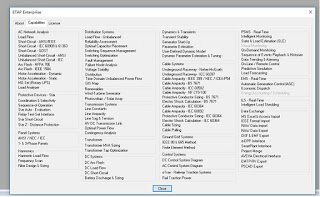Etap_PowerStation_v16.2_download_tutorials_training
ETAP is a fully graphical Enterprise package that runs on Microsoft® Windows® 2008, 2012, 7, 8, 8.1
and 10 operating systems. ETAP is the most comprehensive analysis tool for the design and testing of
power systems available. Using its standard offline simulation modules, ETAP can utilize real-time
operating data for advanced monitoring, real-time simulation, optimization, energy management systems,
and high-speed intelligent load shedding.
ETAP has been designed and developed by engineers for engineers to handle the diverse discipline of
power systems for a broad spectrum of industries in one integrated package with multiple interface views
such as AC and DC networks, cable raceways, ground grid, GIS, panels, arc flash, WTG, protective
device coordination/selectivity, and AC and DC control system diagrams.
ETAP users must be proficient in using basic operations of Windows® environment. Use of ETAP does
not require training. However, to facilitate the learning process, OTI provides workshops throughout the
year in several locations. (Refer to www.etap.com for the up-to-date training schedule.)
ETAP allows you to easily create and edit graphical one-line diagrams (OLD),
underground cable raceway systems (UGS), three-dimensional cable systems,
advanced time-current coordination and selectivity plots, geographic information
system schematics (GIS), as well as three-dimensional ground grid systems
(GGS). The program has been designed to incorporate to three key concepts:Virtual Reality OperationThe program operation emulates real electrical system operation as closely as
possible. For example, when you open or close a circuit breaker, place an
element out of service, or change the operating status of motors, the deenergized elements and sub-systems are indicated on the one-line diagram in
gray. ETAP incorporates innovative concepts for determining protective device
coordination directly from the one-line diagram.
 Software training,tutorials,download,torrent
Software training,tutorials,download,torrent